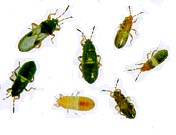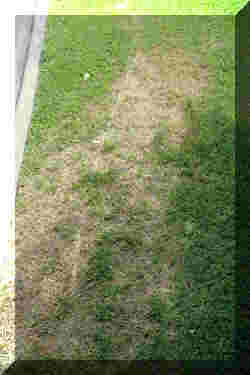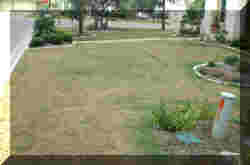|

|
Austin, Texas Chunch bug in grass
Chinch Bugs in St. Augustine Lawns
The southern chinch bug, Blissus insularis, is one of the most important
insect pests of St. Augustine-grass in Austin Texas. Although most damaging in Gulf
Coast regions and in the southern half of the state, chinch bugs can be a
problem anywhere St. Augustinegrass is grown.

Although the southern chinch bug is a serious pest in St. Augustinegrass
lawns, it will feed on zoysiagrass,
centipedegrass, bahiagrass, or bermudagrass. The common chinch bug, Blissus
luecopterus, is a closely-related species that is a pest of grain crops in
Texas and throughout the Midwest. This species also occasionally damages
turfgrass and may be responsible for infrequent reports of chinch bugs in
bermudagrass, fescue, and zoysiagrass lawns.
Identification
Expanding, irregular patches of dead or stunted grass surrounded by a
halo of yellowing, dying grass often provide the first clue to the presence
of chinch bugs. These islands of dying grass tend to increase in size and
merge as insect numbers increase. Damage can develop rapidly, especially in
sunny locations during hot, dry weather (Fig. 1).

Chinch bug damage can be confused with certain lawn diseases or other
physiological disorders. Brown patch is a common disease affecting the leaf
blades of St. Augustinegrass. Brown patch symptoms, however, usually occur
in a circular or semi-circular pattern, as opposed to the irregular-shaped
areas of dead and dying grass that result from chinch bug feeding. Chinch
bug damage also can be difficult to distinguish from that caused by drought.
Detection of significant numbers of the insects themselves is the best proof
that chinch bugs are the cause of the damage.




Chinch Bug Damage favors radiant heat sources such as driveways, sidewalks
and streets
Click picture for more detail
Adult southern chinch bugs are small and slender, 1 /6 to 1 /5 of an inch
long. They have black bodies with white wings. Each wing bears a
distinctive, triangular black mark. Normally, some of the adults at any
given site will have full-sized, functional wings, whereas other individuals
will be short-winged and incapable of flight (see the Tips for Professionals
section for distinguishing chinch bugs from the common beneficial insect,
the big-eyed bug). Recently hatched nymphs (immatures) are wingless, yellow
or pinkish-red, with a light-colored band across their backs (abdomen).
After each molt the nymphs more closely resemble the adults. Before the last
molt, nymphs are black or brownish-black, and have a white spot and two
small wing pads on their backs. Chinch bugs are found most readily in the
weakened, yellowing grass around a dead spot in the lawn.
 Chinch bug favors sunny open areas, Click for larger picture
Chinch bug favors sunny open areas, Click for larger picture
Biology and habits
In Texas, adult chinch bugs are inactive during the winter. Reproduction
begins after the appearance of warm weather in the spring. Under optimal
conditions, each female can deposit up to 300 eggs, which hatch in about 2
weeks. The nymphal stage lasts about 30 days (less during hot weather),
while the entire life cycle lasts 7 to 8 weeks. This speed of development
allows time for three to five chinch bug generations each year. However, as
the season progresses generations tend to overlap heavily, with the result
that all stages normally are found together.
Mouthparts of the southern chinch bug consist of a long, slender beak,
which is held close to the midline of the underside of the insect when not
feeding. Chinch bug damage is due not just to the direct effects of feeding,
but also to phytotoxic effects of the saliva.
 Dead Yard,
click for larger pic Dead Yard,
click for larger pic
Managing chinch bugs
Cultural controls
Control of chinch bugs starts with proper lawn care. Keeping thatch to a
minimum, for example, reduces chinch bug numbers and makes other control
methods more effective. Thatch is the layer of dead plant material found
between the green tops of the grass plant and the soil below. Thatch
provides a protective home for chinch bugs, and chemically binds with many
insecticides, making such controls less effective.
Excessive thatch forms when soil microbes are unable to break down dead
plant material as fast as it is added. Proper mowing practices can help
reduce thatch build up. For optimum turfgrass health, no more than 35 to 40
percent of the leaf blade should be removed at a time when mowing. This
means that lawns generally should be mowed no less often than once a week
during the growing season. Mulching- or recycling-type mowers tear grass
clippings into small pieces that are decomposed more easily by soil
microbes. Research has shown that proper use of mulching mowers reduces the
need for fertilizers and does not contribute to excessive thatch.
When thatch exceeds 1 inch in thickness, it may be necessary to have your
lawn “vertically mowed.” Vertical mowing (a method of physically removing
thatch) can be performed by a professional lawn maintenance company or by
doing it yourself. Vertical mowing can temporarily harm your lawn’s
appearance because it destroys the tightly woven stolon system of St.
Augustinegrass. Vertical mowers can be obtained through many equipment
rental stores.
Lawn aeration, in combination with top-dressing, also can help reduce
thick layers of thatch. Aeration is performed by punching holes in the turf
to increase air and water penetration. Lawn aeration machines can be
obtained from many equipment rental stores, or aeration can be performed by
a professional lawn care company. Aeration, in combination with
top-dressing, helps correct moderate thatch problems by increasing
soil-to-thatch contact, thus speeding up microbial decay. For more
information about main-taining St. Augustinegrass lawns, see Texas
Agricultural Extension Service publication B-5088, “Home Lawns.”
Too little or too much water also can cause chinch bug problems. Chinch
bugs prefer hot, dry environments. Dry weather enhances survival of chinch
bug nymphs and eggs by reducing the incidence of disease. Also,
drought-stressed lawns are more susceptible to chinch bug injury. On the
other hand, over-watering results in saturated, oxygen-deprived soils that
cannot sustain the microbes needed to decompose thatch.
St. Augustinegrass lawns should be watched closely during the summer for
signs of drought stress. The lawn should be watered immediately when edges
of grass blades begin to curl, grass fails to spring back quickly when
walked on, or the turf takes on a dull bluish-gray color. Due to the variety
of soil types and depths in Texas, the amount of water needed will vary.
Whenever possible, apply enough water to wet the soil profile to a depth of
approximately 6 inches and let it dry out between irrigations. Frequent
watering promotes shallow root systems in St. Augustine-grass, making it
more susceptible to injury by chinch bugs.
Resistant varieties
The most commonly planted St. Augustine-grass varieties (including ‘Texas
common’ and ‘Raleigh’) are highly susceptible to chinch bug attack; however,
research has identified several resistant types. The varieties ‘Floratam’, ‘Floralawn’,
and ‘Floratine’ show varying degrees of resistance to feeding by chinch
bugs. ‘Floratam’, however, is the only variety that is commonly sold in
Texas. ‘Floratam’ generally provides a high level of resistance to both
chinch bugs and St. Augustine decline (SAD), a virus disease; however, it
should be planted only in the southern half of the Texas because of its lack
of cold-hardiness. Residents of counties north of Houston and San Antonio
should check with their local county Extension office to determine whether
‘Floratam’ is appropriate for their area.
Biological control
Chinch bugs are attacked by many predatory insects, such as big-eyed bugs (Geocoris
spp.), minute pirate bugs (Xylocoris spp.), and ants. Repeated insecticide
applications can reduce populations of beneficial organisms and actually
lead to increased chinch bug numbers. To preserve beneficial insects, apply
insecticides only when necessary.

New varieties of insect-pathogenic fungi are currently being selected and
tested for chinch bug control. Beauveria bassiana is one such fungus that
has shown potential for control of many pests. Currently, however, there are
no consistently effective fungal controls for chinch bug. Likewise,
beneficial nematodes have provided inconsistent results when used against
chinch bugs. For homeowners who want to avoid the use of any chemicals on
their lawn, these products may provide some measure of control.
Chemical control
Good water and fertility management, thatch control, and use of resistant
grass varieties dramatically reduce the need for insecticides to control
chinch bugs. However, when dead and dying zones in turf-grass are
accompanied by the presence of chinch bugs, some corrective action is
needed. Chemical insecticides, when used according to label directions, can
provide a rapid reduction in chinch bug numbers.
The first step when using pesticides for chinch bug control is to
determine whether a problem truly exists. If your neighborhood is prone to
chinch bug problems, inspect your lawn weekly during the spring, summer and
fall months. Look for off-color areas, especially in direct sun, and along
sidewalks and driveways. When chinch bugs are present in high enough numbers
to cause grass to yellow, they can often be found by parting the grass at
the edge of affected areas and examining the soil and base of the turf (see
Tips for Professionals section). Several checks should be made in areas with
suspected infestations. With heavy infestations, small numbers of chinch
bugs may be seen walking on leaves or scurrying about on adjacent sidewalks
on hot days.
When chinch bugs are abundant enough to cause visible damage, insecticide
use can prevent further injury. A variety of liquid and granular
insecticides is available to control chinch bugs. Granular insecticides can
be applied with a standard fertilizer spreader and irrigated lightly ( 1 /8
to 1 /4 inch of water) to activate the insecticide. Drop-type spreaders are
recommended to avoid scattering insecticide granules into gutters, sidewalks
and driveways, where the granules can be washed into storm drains and
streams. Any granules landing in such sites should be swept up and reapplied
properly.
Liquid sprays are usually applied using a hose-end sprayer that can apply
15 to 20 gallons of water per 1,000 square feet. To ensure even coverage,
spray back and forth across the same area. Irrigation is not recommended
following application of liquid insecticides. Watering the lawn before
application can help the pesticide penetrate into the turf.
In cases where chinch bugs are restricted to isolated areas of the lawn,
use spot treatments. Treat the off-color turf and all surrounding infested
areas. Inspect the site every 3 to 5 days for at least 2 weeks to determine
if the infestation is under control. Spot treatments minimize the impact of
pesticides on beneficials and help avoid environmental contamination.
Products containing diazinon, chlorpyrifos (Dursban®), or acephate (Orthene®)
are suggested for homeowner applications. Chinch bugs have been reported
with resistance to the above products in some areas of Florida; however,
this has not been apparent in Texas. Where any of these products fail to
provide control, apply a synthetic pyrethroid such as permethrin (e.g.,
Spectracide® Liquid Insecticide Spray).
Safety precautions
Always wear appropriate clothing when applying pesticides. Read the label to
see what protective equipment should be worn. Minimal protective clothing
includes long pants, shirt, shoes and socks. Unlined, chemical-resistant
gloves are recommended whenever mixing liquid pesticides. Treated areas
should be allowed to dry thoroughly before permitting people or pets to walk
or play on the treated grass. Always check the label for information
concerning safe re-entry times.
Some communities in Texas experience periodic sewage contamination due to
improper pesticide use and disposal. Check label directions for special
instructions on disposal of empty containers. Never dispose of unused
pesticides down storm sewers, toilets, or sinks. This pollutes the
environment and can result in costly cleanups for your community. Clean up
pesticide spills immediately. Should any pesticide threaten to enter a storm
drain, stream, or lake, call the Texas State Environmental Emergency
Response Hotline at 1-800-832-8224.
Insecticide label clearances are subject to change, and changes may have
occurred since this publication was printed. The pesticide USER is always
responsible for the effects of pesticides on his own plants or household
goods as well as problems caused by drift from his property to other
properties or plants. Always read and follow carefully the instructions on
the container label.
Tips for Professionals

- An approximate action threshold (level at which damage begins to
appear) for chinch bugs on susceptible St. Augustinegrass varieties,
(e.g., ‘common’ and ‘Raleigh’) is 20 to 25 chinch bugs per square foot.
- An alternative sampling method to simply parting the grass and looking
for the insects is the flotation method. A coffee can (with the top and
bottom lids removed) should be pushed into the ground with a twisting
motion. Use a knife, if necessary, to cut the grass around the rim. Fill
the can with water for about 10 minutes and check for chinch bugs as they
float to the surface. Action thresholds for samples taken with 4-inch and
6-inch diameter coffee cans are an average of two, and four to five chinch
bugs per sample, respectively. Several samples should be taken from
different locations in the damaged (not dead) grass.

- Big-eyed bugs closely resemble, and often are mistaken for, chinch
bugs. Big-eyed bugs are beneficial predators that kill chinch bugs and
many other pests. Although similar in size to chinch bugs, big-eyed bugs
have large, protruding eyes and a head at least as wide as the thorax (the
leg-bearing part of the body). Chinch bugs have small heads (narrower than
the thorax); eyes are small in proportion to the head; and their bodies
are more slender. Big-eyed bugs do not have the distinctive white wings
with black triangular marks that chinch bugs have.
- Additional labeled pesticides for professionals include bendiocarb (Ficam®,
Turcam®), bifenthrin (Talstar®), ethoprop (Mocap®, golf courses only),
fonofos (Crusade®, Mainstay®), imidacloprid (Merit®), isofenphos (Oftanol®),
lambda-cyhalothrin (Scimitar®*, Battle®*), and permethrin (Astro™).
Resistance of chinch bugs to organo-phosphate insecticides has been
reported in other states. In case of suspected resistance, rotate to
another class of insecticide. Note that diazinon may not be applied to
golf courses or sod farms.
- Use of surfactants in spray solutions may enhance control, especially
in turf with heavy thatch.
- Regular, light top-dressing of turfgrass with compost, or soil similar
to the existing soil, can help lessen thatch problems.
- In turfgrass that is regularly infested with chinch bugs, use organic,
or slow-release, nitrogen sources and try lowering the rate of applied
nitrogen. Lower rates of nitrogen (e.g., 2 pounds of nitrogen per 1,000
square feet per year) have been shown to make grass less attractive to
chinch bugs and can reduce the need for sprays.
Free analysis and price quote


|



